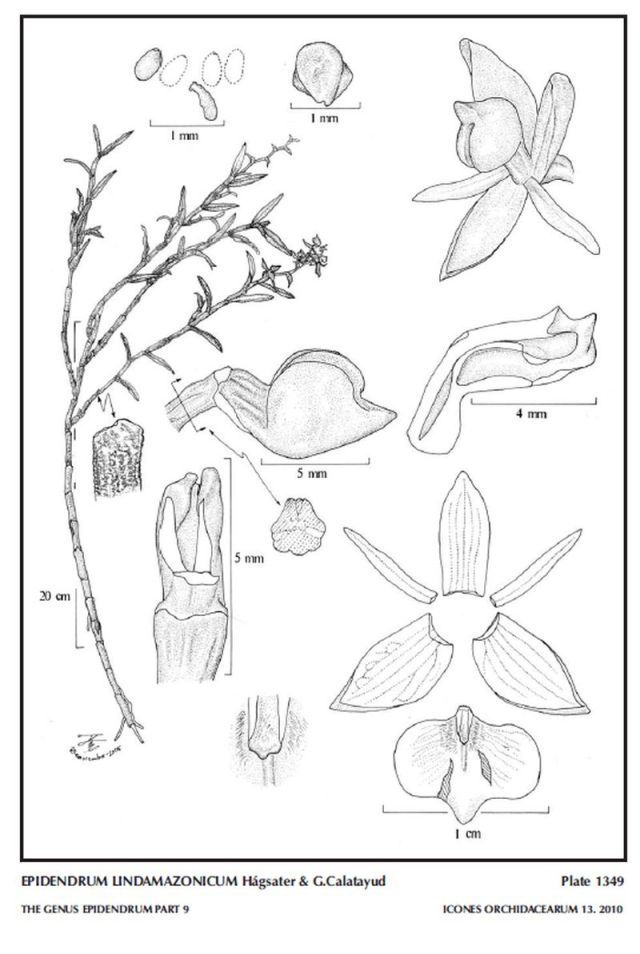

Epidendrum lindamazonicum Hágsater & G.Calat. GROUP Aquaticum
TYPE Drawing by Jimenez and The AMO Herbaria Website

 LATE
LATE 

Common Name The Amazonian E lindae Epidendrum
Flower Size .8" [2 cm]
Found in northern Peru on the Amazon slope of the Andes at elevations around 2200 meters as a large sized, cold growing terrestrial with erect, branching towards the apex of the mature stem, cane-like, terete, somewhat flexuous, branches shorter than the main stem carrying numerous on the main stem, 6 to 11 on the branches, all along the stems, narrowly lanceolate-elliptic, subacute, aristate, prominent dorsal keel, margin somewhat undulate leaves that blooms in the late summer through fall on a terminal, occuring only once, racemose, distichous, erect, peduncle terete, .28 to .6” [7 to 15 mm] long, rachis terete, sinuous, 1.32 to 1.92” [3.3 to 4.8 cm] long overall, simultaneously 3 to 5 flowereed inflorescence with longer to progressively shorter than the ovary, triangular, acute, floral bracts carrying non-resupinate, lip always oriented to the rachis, greenish yellow and cream colored flowers.
" Epidendrum lindamazonicum belongs to the GROUP Aquaticum characterized by the branching habit, distichous inflorescence, fleshy flowers and pubescent nectaries. The new species is recognized by the short plants, small, narrow, lanceolate-elliptic leaves, the erect, few-flowered, racemose inflorescence, sinuose, rachis, and the 3-lobed lip, large subquadrate, lateral lobes, the corners rounded, and the mid-lobe small and triangular, the column bent down at the base at about 45°; the callus and surrounding area is prominently pillose. It is very similar to E. lindae Hágsater & Dodson which has larger, wider leaves, a branching inflorescence, linear petals and a triquetrous ovary, the lip is only slightly cuneate but 3-lobed, with the lateral lobes subquadrate. Epidendrum stenocalymmum Hágsater & G.Calatayud is recognized by the small, ovate leaves, simple, erect raceme, entire, oblanceolate, unguiculate petals and the cuneate lip forming a deep sac in front of the column, so that the column is not visible. Epidendrum campylorhachis Hágsater has a 3-lobed lip with the base cuneate, narrowly oblanceolate petals and an oblique, deeply triquetrous ovary, in addition, the rachis segments are prominently incurved below each bract. The new species has been confused with Epidendrum alsum Ridley ex Thurn, a Venezuelan species with larger habit and leaves, a paniculate inflorescence and somewhat 3-lobed lip, the basal lobes broadly rounded, the petals elliptic. Epidendrum bractiacuminatum Hágsater & Dodson also has a distichous inflorescence, but is much larger overall, leaves 5.2 to 7.2" [13 to 18 cm] long, floral bracts .6 to .18" [15 to 45 mm] long, sepals .48 to .68" [12 to 17 mm] long, and the lip is cordiform." Hagsater etal 2010
Synonyms
References W3 Tropicos, Kew Monocot list , IPNI ; * Icones Orchidacearum 13 plate 1349 Hagsater & Santiago 2010 drawing fide; Icones Orchidacearum 15 [1] Plate 1557 Hagsater & Sanchez 2015 see recognition section; Icones Orchidacearum 16[1] Plate 1647 Hagsater 2018 See recognition section
--------------------------------------------------------------------------------------------------------------------------
--------------------------------------------------------------------------------